Research Article
E-BUSINESS ADOPTION: AN IMPLICATION OF TECHNOLOGY ACCEPTANCE MODEL FOR STONE TOWN, ZANZIBAR
63227
Views & Citations62227
Likes & Shares
Purpose: This study seeks to explain E-Business Adoption by using a Technology Acceptance Model (TAM) for Stone Town, Zanzibar.
Design/Methodology/Approach: The proposed order of the model is that perceived usefulness, perceived ease of use and E-business literacy predict E-business adoption. These measures capture our research questions. We used purposive sampling approach to gather data from Stone Town Destination officers. During December 2019 to February 2020, 129 filled questionnaires were gathered in which only 122 was usable for further analysis. Final questionnaires were analyzed using SPSS and SEM (AMOS).
Main results: The findings showed that perceived usefulness, perceived ease of use and E-business literacy had positive and significant effect toward E-business adoption.
Originality of the research: The paper strengthens TAM theory that individual behavior intention to adapt E-business is influenced by their perception of usefulness, ease of use and E-business literacy. This study has proved the applicability and ability of TAM to be an antecedent toward-business adoption in Stone Town, Zanzibar.
Implication: From the finding of this study, for proper management and fully realization of the contribution of tourism to Zanzibar economy, E-business adoption of Stone Town destination is inevitable. For Zanzibar tourism ministry the study is important for policy formulation particularly those relating to E-business usage in order to create a conducive business environment which will nature the growth of the tourism industry.
Keywords: Zanzibar, Perceived Usefulness, Perceived Ease of Use, ICT Literacy, ICT Adoption, SEM
INTRODUCTION
This study focuses on E-business adoption by using a Technology Acceptance Model (TAM) for Stone Town. E-business plays an important role in tourism industry and these roles should not be underestimated (Bethapudi, 2013; Shanker, 2008). It has allowed destination managers to promote and distribute information about their attractions (Adukaite et al., 2016). Tourists travel behavior has been always influenced by development of E-business for example, a traveler who is interested in visiting any destination, he/she goes online and access variety of online in search of satisfying her/his information needs (Garbelli, 2015).
E-buinsee reduces operating costs, raise value to customers, achieve strategic competitive customers, and achieve strategic competitive advantage (Kamuzora, 2016). Any businesses using the internet regularly have seen their share growing faster (Ismail, 2016). In order to run online communication effectively and efficiently and win the currently tourism market share, destination managers are supposed to invest on time, resources and effort to deliver accurate and clear message, update the contents on a regular basis and interact with online customers (Munar & OOi, 2012).
This constantly changing environment presents many challenges to many tourism destinations specifically those who are not utilizing ICT in efficiently and effectively way to meet the global international destination standards and to increase the supply of information (Bystrowska et al., 2017). Therefore, tourism destination needs to set out critical measures to ensure effectively and efficiently use of ICT in order to gain international visibility of their attractions, increased access to global supply chains, empowers the individual with the information access and increase demands for greater openness and transparency. This notion, tells that, for the success of any tourism business, adaption to ICTs innovation is inevitable. However, mostly tourism business owners/managers in Tanzania lack an understanding that investment and use of ICT is a major prerequisite in forming strategic alliances, developing innovative distribution methods and communicating with customers and partners while satisfying customers demand (Mtweve, 2013; Monko et al., 2017).
Likewise, some tourism destinations are faced with challenges of not utilizing E-business in efficiently and effectively way to meet the global international destination standards, to increase the supply of information and be integral to a country’s development strategy (Bystrowska et al., 2017). In Zanzibar specifically, there is a problem of low ICT adoption in e-booking and reservation system is still minimal resulting poor efficiency in their daily operation and unsatisfied customers (Abdulrahman, 2020). Therefore, tourism destination needs to set out critical measures to ensure effectively and efficiently use of ICT in order to gain international visibility of their attractions, increased access to global supply chains, empowers the individual with the information access and increase demands for greater openness and transparency (Kim & Kim, 2017). One way to achieve this is through investment in ICT innovation which will eventually lead to ICT usage.
E-business adoption and usage in tourism industry provided destination management organization with the possibility of reaching tourist and prospects in a direct way such as online promotion and marketing, distribution of tourism products, managing and coordination of all stakeholders involved in the creation and delivery of tourism product (Adukaite et al., 2016). Thus, there is a need to further assess E-business adoption factors by using a Technology Acceptance Model (TAM) for Stone Town of Zanzibar, a failure in addressing this, Zanzibar will not be able to compete with similar destinations not only in Africa but in the World market (Mwita, 2014; Gastelú et al., 2014).
Zanzibar is rich in tourism attractions ranging from a peaceful atmosphere, friendly people, UNESCO historical sites which include stone town, rich in cultural and sunny climate, sand beaches and endowed with cool and fleshing sea breeze (Gastelú et al., 2014). However, E-business utilization and usage in e-booking and reservation system is minimal which would have transformed the destination service delivery system (Kim & Kim, 2017). Most SMEs in Zanzibar still use the traditional marketing strategies instead of transforming to online marketing, thus cannot compete in the global business environment (Kim & Kim, 2017).
Factors resulting into minimal ICT utilization in Zanzibar tourism destination are such as low internet speed, unreliable electricity, high cost of ICT installation, subscription and upgrading, lack of ICT investors, lack of ICT skilled personnel as well as unreliable ICT providers (Adukaite et al., 2016). Based on the available literatures, none has explained E-business adoption by using TAM theory, hence providing the basis for conducting this study to fill both theoretical gap and contextual gap.
LITERATURE REVIEW
Historically, it has been revealed that, from 1990s ICT usage has proven to improve firms’ productivity levels (Zhu, et al., 2005). With regard to heritage organization, computer is also one of the essential tools in ICTs to improve organization performance. One major explanation for increasing organization performance is through the adoption and use of ICT (Oliveira & Martins, 2011).
(Teeroovengadum et al., 2017) conducted a study using a hierarchical regression analysis to access the determinants of E-business adoption by educators in the teaching and learning process in the context of a developing country, Mauritius. Results from the study suggested that perceived usefulness (PU) and perceived ease of use (PEOU) were both found to have a significant positive direct effect on E-business adoption. The results provide a better understanding of the applicability of the TAM model to the Mauritian secondary education context and also enhance the understanding of other important variables in determining E-business adoption by teachers.
(Lion, et al., 2018) applied Technology Acceptance Model (TAM) to explore the behavioral intention of students in technological colleges and universities. Structural equation model was used to test the hypothesis of the study. The finding revealed that TAM is the perfect theory to apply to explain users’ willingness to adopt a web-based assessment system. They argued, perceived usefulness and preserved ease of use as a tool to evaluate their technical proficiency in e-book production.
(Alambaigi & Ahangari, 2016) conducted a study which aimed to develop Technology Acceptance Model (TAM) model to explain adoption of information technology by using descriptive correlation. Through a survey method, measurable variables were developed and the finding of the study revealed that job relevance and experience had positive significant effect on ICT adoption. TAM is one of the most influential extensions of Ajzen and Fishbein’s theory of reasoned action (TRA) in the literature. The theories behind assumes that when a person forms an intention to act, that s/he will be free to act without limitation.
(Jimenez, et al., 2021) explored the external variables that could influence the acceptance of a 3D learning environment for farmers in Europe through Quality Function Deployment (QFD) analysis. This study confirmed the presence of a strong and significant impact of the perceived usefulness and perceived ease which validated the significance of the relationship established under TAM theory. This study is expected to bring theoretical support for academics when determining the variables to be included in TAM extension.
(Matikiti, et al., 2018) explored the factors that influence attitude towards the use of social media marketing by travel agencies and tour operators in South Africa. The study applied a quantitative approach through the use of questionnaires and multiple regression analysis was used to analysis the data. The finding indicated that perceived benefits and perceived ease of use were found to be the most prominent external factors which influence the use of social media marketing while ICT literacy proved to be the internal factors towards social media marketing. Likewise, (Park, et al., 2018) investigated the factors that influence user acceptance intranets in the restaurant industry in the United State.
TAM theory was applied to the study to predict system usage and a survey method was applied for data collection. A factor analysis was conducted using principal axis factoring with varimax rotation as an extraction method. The results of the study showed that perceived usefulness was the main factor influencing intranet acceptance, while organization support, information quality, and perceived ease of use were not significant in the regression analysis. The findings indicate perceived usefulness of intranet use requires focus in order to improve communications in restaurant franchise systems in USA.
THEORETICAL BACKGROUND
Technology Acceptance Model (TAM)
There are various theories that are associated with ICT adoption being acceptance or rejection, in 1985, Fred Davis proposed TAM in his Doctoral thesis at the MIT Sloan School of Management (Hung, et al., 2005). TAM is one of the popular theories of ICT adoption in organization and it deals with user acceptance of technology. TAM suggests that, individual acceptance and use ICT in two different ways namely; “perceived usefulness” (PU) which means the degree to which an individual believe that ICT usage in an organization would enhance their job performance and “perceived ease of use” (PEOU) which is a degree to which an individual believe that ICT usage would enhance their job performance (Gefen, et al., 2003). (Tom Dieck & Jung, 2015) acknowledged that TAM theory is considered one of the most influential theories for addressing user acceptance of ICT in the organization.
(Oliveira & Martins, 2011) criticized TAM theory by arguing that is not usefully for investigating acceptance level of ICTs usage to an organization. However, the decision to adopt and use E-buisness within the organization is not based on individual level of acceptance rather it incorporates range of strategic firm level. In reality, most organizations require their employees to engage with the system available with no other alternatives. (Ervasti & Helaakoski, 2010) criticized the theory of TAM by arguing that, behavior should not be considered as a terminal goal instead they should be treated a means to a more fundamental goal. He further argued, intention to use may not be a representative enough actual use. Because the interval period between intentions to use and the implementation (using the system) could be hindered with many factors, that might influence an individual’s decision to use E-business in both positive and negative ways.
A person intention could be subjected to evaluation and reflection, which might influence a person to make a different course of action. This study will focus on the strength of TAM theory by looking on E-business adoption factors (perceive usefulness and perceived-ease-of use) therefore correct to conclude that TAM theory through E-business adoption variables measures the relationship between E-business adoption (perceive usefulness and perceived-ease-of use) and WHSs. They application of the theory in the study is justified by the fact that, for Zanzibar WHSs to adopt E-business it must be influenced by TAM variables.
Although the Technology Acceptance Model (TAM) (Davies, 1989) have already been extensively studies (Cassim & Obono, 2011; Terzis &Economides, 2011). much of the variation in E-business adoption remain unexplained and there is still lack of studies that investigated into the incremental effect of other determinants such as perceived usefulness, perceived ease-of-use and E-business literacy toward E-business adoption into Stone Town in Zanzibar. This research concludes that the TAM can be applied to explain users’ willingness to adopt E-business in their daily operation (Liao et al., 2018). This study also applied structural equation model as a vehicle to test the hypotheses and relationships in the research to verify E-business adoption factors.
Research Model and Hypotheses
The objective of this paper is to test E-business adoption by using a Technology Acceptance Model (TAM) for Stone Town of Zanzibar through testing three hypotheses. Based on the available literature review, the model for the study indicating the antecedent of ICT adoption was developed in (Figure 1). The model contains three factors that have an effect on E-business adoption. Perceived usefulness, perceived usefulness is defined as the degree to which an individual believes that a target system will enhance his or her job performance (Davis, 1989).
Perceived usefulness (PU) means the degree to which an individual believes that usage and implementation of ICTs system into an organization would enhance their job performance. PU has been proved as an important factor that influences user technology acceptance (Park et al., 2018). Therefore, the following hypothesis is proposed for this study:
H1: Perceived usefulness has a positive direct influence on adoption of ICT
Perceived ease of use (PE) is a degree to which an individual believe that usage and implementation of ICTs system would be free from effort (Manueli, et al., 2007; Oliveira and Martins, 2010). PE further indicates the individual’s perception concerning the amount of effort required to use the system (Park et al., 2018; Li, 2015). As a result, the following hypothesis is proposed:
H2: Perceived Ease of Use has a direct positive effect on Adoption of ICT
E-business literacy is the degree to which an individual possesses knowledge and capability in operating, processing, changing, accessing and using ICT software and hardware (Osorio, et al., 2013). E-business knowledge in operating the above elements is an essential and key point for our study as it is one of the antecedents of ICT adoption. Lack of E-business knowledge within the organization is regarded to be a barrier top E-business adoption thus causes difficulties in realizing the full potential brought by ICT investment (Oliveira Martins, 2011). Therefore, the following additional hypotheses is proposed for this study.
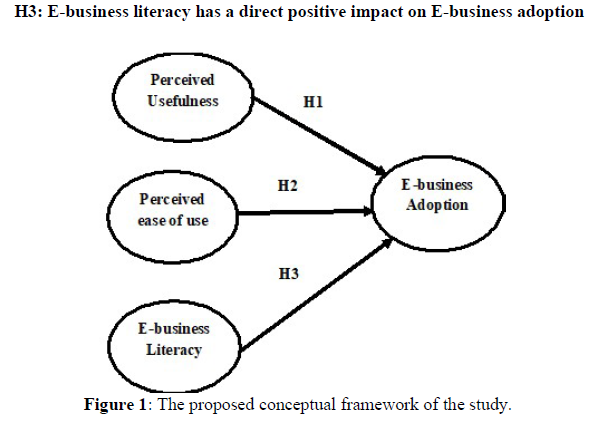

METHODOLOGY
Study area
The selected area for this study was the Stone Town of Zanzibar which is an outstanding UNESCO property and it maintain a manifestation of cultural fusion and harmonization. It was inscribed on UNESCO's World Heritage List in 2000 as a site of cultural value; more specifically it is considered a Historic Urban Landscape (UNESCO, 2017). Stone Town reflect the memories off all the slave trade which were sold in Zanzibar, it reflects the memories of few European explore to Africa such as Vasco da Gama, Livingston, Speake, Stanley and Burton (Hitchcock, 2010). It is regarded as an outstanding tangible and intangible cultural heritage sites that manifest its interaction through several millennia and thus bears unique universal values (Hitchcock, 2010).
Sample design and data collection
The data were collected in December 2019 to Feb 2020. Respondents were asked to take about 20 – 30 minutes of their time to complete the questionnaire. This study collected data by self-administered questionnaires. This process involved the World Heritage Sites (WHS) decision makers filling out semi structured questionnaires after the researcher had sought consent from them and later explained the aim of the study. The responded were found in their office during working hours. A convenience sampling technique was employed. A total of 129 questionnaires were self-administered to different officers. Due to the limitation posed by the convenience sampling technique, the data do not represent the entire population. Data were analyzed using the Statistical Package for the Social Sciences (SPSS 24); later, to fully test the proposed model, an SEM approach was used.
Instruments
Each variable is measured using instruments developed in past studies. Perceived usefulness is measured using six items and it is adopted from (Hu et al., (2002); perceived ease of use is measured using five items and they were borrowed from Lee and Colleagues in 2006; E-business literacy is measured by four items, which were adopted from Otieno (2015); and E-business adoption is measured using 3 items and it was adopted from Kilangi (2012). All the questions for the study were measure with a five likert scale, where 1=strongly disagree, 2 = disagree, 3 = neutral, 4 = agree, 5 = strongly agree.
Criterion of Goodness of Fit indices
When using SEM, researchers frequently use multiple goodness of fit indices to judge the strength of the model and tell whether there is an acceptable fit between the observable data and the model. There are several criteria accepted, but this study used the one suggested by Iacobucci (2010) in which the Chi-square/Degree of freedom (CMIN/DF), Goodness of Fit Index (GFI), Tucker-Lewis Index (TLI), comparative fit index (CFI), and root mean square error of approximation (RMSEA) are used as criteria for determination of goodness of fit indices and the acceptable fit indices are depicted in (Table 1).
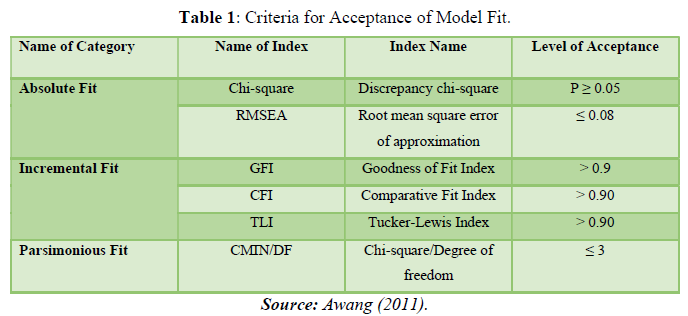
RESULTS FROM EXPLORATORY FACTOR ANALYSIS (EFA)

RESULTS FROM EXPLORATORY FACTOR ANALYSIS (EFA)
EFA is used to measure the relationship between variable and the respondent and explain them in terms of their common underlying dimensions. The goal of EFA is to reduce the dimensionality of the original space and to give an interpretation to the new space, spanned by a reduced number of new dimensions which are supposed to underlie the old ones (Okello & Yerian, 2009).
EFA offers not only the possibility of gaining a clear view of the data, but also the possibility of using the output in subsequent analyses. EFA is usually preceded by Kaiser-Mayer-Olkin (KMO) measure of sampling adequacy (KMO test) offers a convenient option to test whether the sample is big enough (Awang, 2011). The sample is adequate if the value of KMO is greater than 0.5 (Williams, et al., 2010), while (Tabachnick & Fidell, 2007) concluded that, in order to warranty the application of EFA, the KMO statistic value should range from 7 (Table 2).

In this study the findings have met the above criteria as the KMO value was 0.848 while Bartlett’s Test of Sphericity was significant at p < 0.000. Bartlett’s Test of Sphericity tests the null hypothesis that the original correlation matrix is an identity matrix” (Field 2000: 457) it has to provide a chi-square output which must be significant. Hence suggesting that the sample size was adequate and that the data were appropriate for application of factor analysis as the structure was not an identity matrix, the sample also was adequte to run for CFA and SEM. These results are summarized in (Table 2).
Acceptable Loadings
For this study, four factors were retained and contained at least loading factors Eigenvalues greater than 1. For example, factor 1 represent perceived usefulness (PU), factor 2 represent perceived ease of use (PE), factors 3 represent ICTL adoption/usage (ICTU), and factors 4 represent E-business/ICT literacy (ICTL). Details of factors and their underlying factor loadings are presented in the pattern matrix in (Table 3).
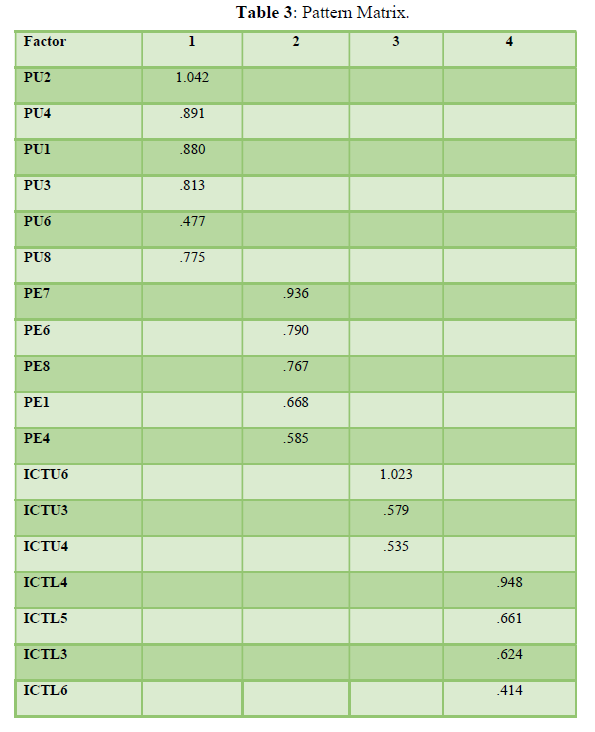

Overall CFA Model
The overall CFA model that fits all the four constructs for this study was tested. After the initial run, all the produced standardized regression weights were above 0.5 as a rule of thumb proposed by Hair et al. (2010) and significant at p ≤ 0.000 within the acceptable critical ratio (CR) of above ±1.96 and standardized residual covariance within the acceptable range below 2.58. The overall CFA model is depicted in (Figure 2).
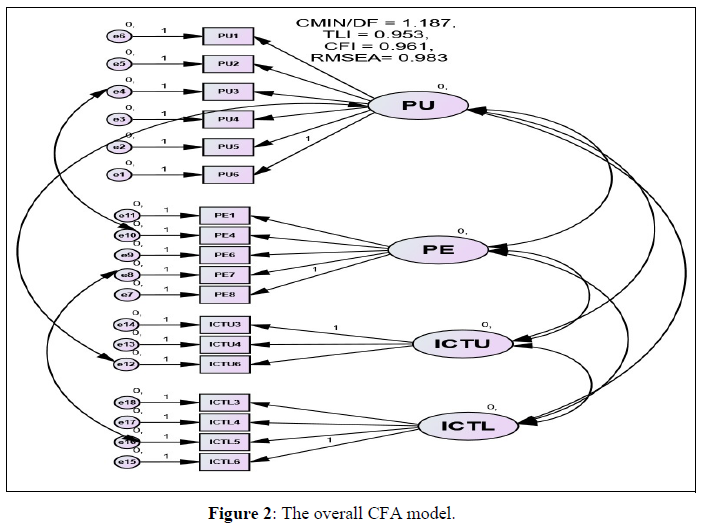

In addition, the standardized model produced the following fit indices as shown in table 1 above; CMIN/DF = 1.290, TLI = 0.953, CFI = 0.961 and RMSEA= 0.983. This show a good model fit and (Figure 2) present the overall CFA model for the study and Table 4 sumarrizes the model estimates.
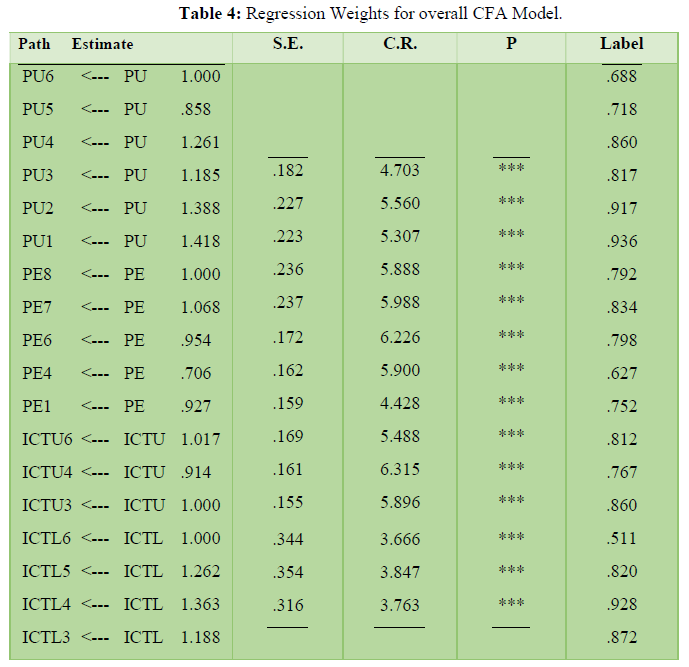

Testing the structural Model for overal sample
The structurural model was tested to the overal sample, following the acceptance of the overall measurment model with its fit indices and parameter estimates. Based on the conceptual framework of the study, the structural association encompaed the following; Perceived usefulness (PU) on ICT adaption; Perseives eas of use (PE) on ICT adoption and ICT literacy on ICT adaption(ICTL). After testing the model, the model produced the following fit indices as recommended from table 1 above; CMIN/DF = 1.290, TLI = 0.928, CFI = 0.936 and RMSEA= 0.078 as illustrated in (Figure 3) and (Table 5) which indicates the standardized and unstandardized value for the overall structural model.
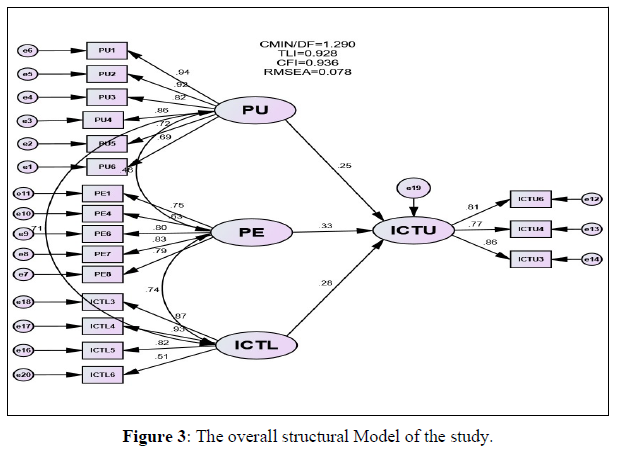

Model Path Coefficients and Hypothesis Testing


Model Path Coefficients and Hypothesis Testing
The hypothesized relationships as indicate above are examined against various coefficients and scores obtained from the analysis. In this study the hypotheses are tested based on the direction, the strength of the standardized paths coefficient (β), the critical ratio (C.R), and significance level (p-value). (Figure 4) depict the SEM relationship between PU and ICTU (ICTU).
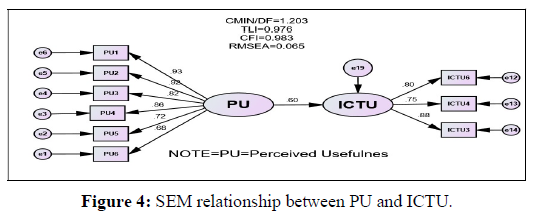
In order to determine the significance of the influence of perceived usefulness (PU) on ICT adoption (ICTU) as illustrated in (Table 6). The path leading from PU to ICTU in table 5 was used to examine the hypothesized relationship (H1) that there is a positive relationship between perceived usefulness (PU) and ICT adoption (ICTU). The test for this hypothesis showed that PU has positive and significance related to ICTU (γ = 0.255; C.R = 3.356; p = 0.000), meaning that when Zanzibar WHSs decision makers perceive usefulness by 1 standard deviation, ICTU adoption goes up by 0.255 standard deviations. This implies that a higher level of PU would result in a greater level of ICTU adoption. Hence, the H1a of the study is supported as it also depicted in the relationship between variables under the fit indices as reflected in (Figure 4).
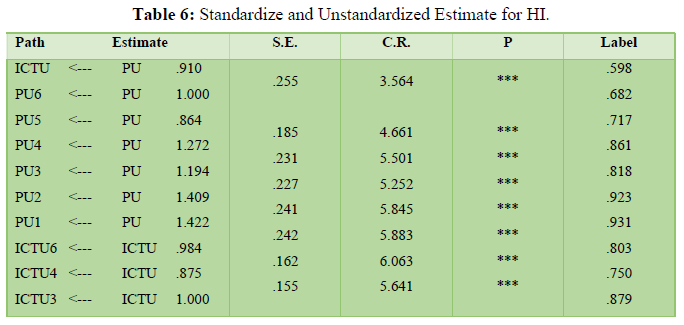
The Relationship between perceived ease of use (PE) and ICT Adoption

The Relationship between perceived ease of use (PE) and ICT Adoption
From the argument made above, there is a positive relation between perceived ease of use (PE) and ICT adoption, the SEM model in (Figure 5) indicates this relationship.
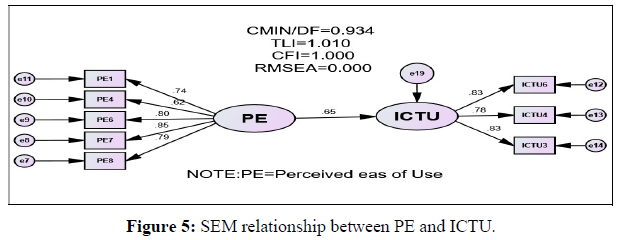
In order to determine the significance of the influence of perceived ease of use (PE) on ICT usage (ICTU) as illustrated in Table 6, the path leading from PE to ICTU in table 6 was used to examine the hypothesized relationship (H2) that there is a positive relationship between perceived ease of use (PE) and ICT Usage (ICTU). The test for this hypothesis showed that PE has positive and significance related to ICTU (γ = 0.266; C.R = 3.545; p = 0.000), meaning that when Zanzibar WHSs decision makers perceive ease of use by 1 standard deviation, ICTU goes up by 0.266 standard deviations. This implies that a higher level of PE would result in a greater level of ICTU. Hence, the H2 of the study is supported (Table 7).
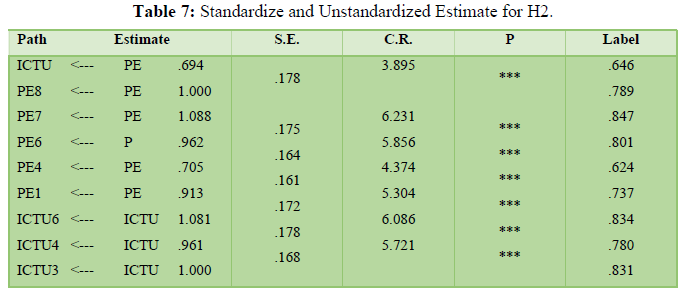
The Relationship between ICT Literacy (ICTL) and ICT Adoption

The Relationship between ICT Literacy (ICTL) and ICT Adoption
From the argument made above, there is a positive relation between ICTL Literacy (ICTL) and ICT adoption, the SEM model in (Figure 6). indicates this relationship.
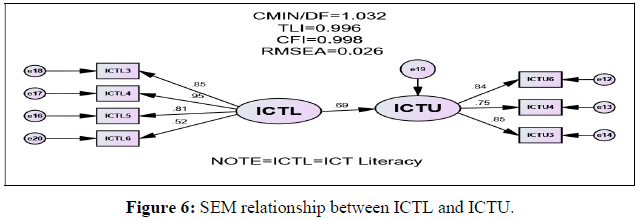

In order to determine the significance of the influence of ICT Literacy (ICTL) on ICT usage (ICTU) as illustrated in (Table 8). The path leading from ICTL to ICTU in Table 7 was used to examine the hypothesized relationship (H3) that there is a positive relationship between ICT Literacy (ICTL) and ICT Usage (ICTU). The test for this hypothesis showed that ICTL has positive and significance related to ICTU (γ = 0.365; C.R = 3.255; p = 0.001), meaning that when Zanzibar WHSs decision makers level of ICT literacy is perceived by 1 standard deviation, ICTU goes up by 0.365standard deviations. This implies that a higher level of ICT Literacy would result in a greater level of ICTU. Hence, the H3 of the study is supported (Table 9).
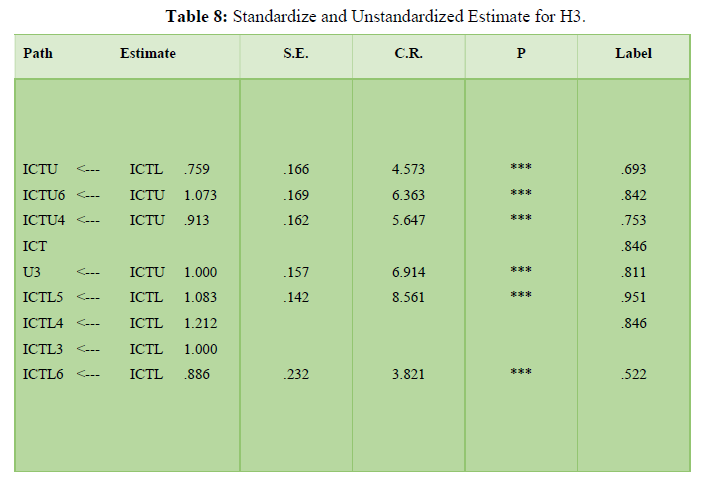
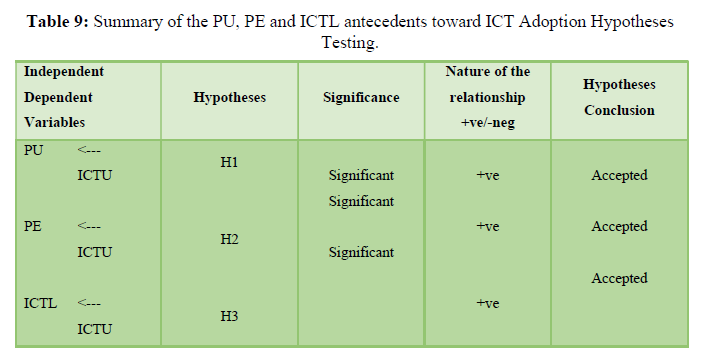


DISCUSSION
This study was inspired by the need to learn more about E-business adoption by using a Technology Acceptance Model (TAM) for Stone Town of Zanzibar. The findings provide evidence that perceived usefulness, perceived ease of use and E-business/ICT literacy are the main antecedents toward E-business adoption in Zanzibar World Heritage Site. To start with, it was found that perceived usefulness had a positive significant effect on E-business adoption (H1). The finding was consistent with what Phatthana and Mat (2010. P198) found that perceived usefulness influences positive image of a company website. “The higher the image of websites, the higher the perceived usefulness of the health care web page”. Likewise, Park et al., (2018) found that perceived usefulness was the main factor influencing intranet acceptance while Wagaw and Mulugeta (2018) found that perceived usefulness has a positive and significant association to use ICT in Ethiopia tourism. Thus, decision makers are more interested to adopt ICT in their daily tourism operation when they think that such technology will be helpful.
It was also found that perceived ease of use had a positive significant effect on E-business adoption (H2). The general concept of the findings was consistent with previous studies showing that perceived ease of use had an effect on E-business adoption (e.g., Wagaw and Mulugeta, 2018; Matikiti et al., 2018; Bundot et al.,2017). Thus, Zanzibar World Heritage Sites decision makers should be encouraged to use ICT such as computers/laptops, and other facilitating conditions to support the UNESCO site.
Interestingly, E-business/ ICT Literacy had a positive significant effect on E-buisness Adoption. Conceptually, ICT in the tourism industry started in the early 2000 (Butiku, 2010). Kilangi (2012) argues, ICT development among SMEs in the tourism industry in Tanzania is largely unknown. Thus, a positive effect between E-business/ ICT Literacy and ICT adoption confirmed in the study shows that an important cue for World heritage sites in Zanzibar to provide improved ICT system. Numerous studies in tourism had found similar findings (Phatthana and Mat, 2010; Bundot et al., 2017; Matikiti et al., 2018).
LIMITATIONS AND RECOMMENDATION
This study focused only on Zanzibar UNESCO World Heritage Site, which may not give a true reflection of ICT adoption in Tanzania tourism industry. There is a need to focus on other areas in tourism, such as Tourist Board, National Parks, chain hotels and lodges. The increased use of ICT in tourism business leads to a substitution of ICT equipment for other forms of capital and labor and may generate substantial returns for enterprises that invest in ICT and restructure their organization. The results of this study can give only a snapshot of what is happening in Zanzibar, whereas a longitudinal study will give an indication of what is happening over a period of time.
CONCLUSION
Conclusively, this study focused on E-business adoption by using a Technology Acceptance Model (TAM) for Stone Town. Perceived usefulness, perceived ease of use and E-business/ICT literacy found constructs with positive significant influence E-business adoption. Therefore, the theoretical contribution of this study is the empirically test a research model based on theory of TAM using ICT to aid E-business adoption. As expected, the resulted have supported the theory proposition that individual behavior intention to use ICT in influenced by their perception of usefulness, ease of use and E-business/ ICT literacy. This study has proved the applicability and ability of TAM to be an antecedent toward ICT adoption in Zanzibar World Heritage Sites.
For practical contribution, our empirical study provides the guidance for policy makers, destination marketing officers, national tourism officers and all related tourism decision maker in Zanzibar and other areas with similar destinations/attractions. The findings indicate that the significant and positive relation between PU, PE and ICTL on ICT adoption are both generic perceptions and quality perceptions toward improving ICT adoption in a destination.
- Adukaite, A., van Zyl, I., & Cantoni, L. (2016). The Role of ICT in Tourism Education A Case Study of South African Secondary Schools. In Review of Tourism Research (eRTR). ENTER Conference of Information and Communication Technologies in Tourism 7.
- Alambaigi, A., & Ahangari, I. (2016). Technology acceptance model (TAM) as a predictor model for explaining agricultural experts’ behavior in acceptance of ICT. International Journal of Agricultural Management and Development 6, 235-247.
- Awang, Z. (2011). A Handbook on SEM Structural Equation Modelling Kelantan Universiti Teknologi MARA.
- Bethapudi, A. (2013). The role of ICT in tourism industry. Journal of Applied Economics and Business 1(4), 67-79.
- Bundot, G.Y., Yunos, J.M., & Mohammed, M. (2017). Technology Acceptance Model of Intention To Use ICT By Academics In Nigerian Higher Education. Online Journal for TVET Practitioners 2(1).
- Bystrowska, M., Wigger, K., & Liggett, D. (2017). The use of information and communication technology (ICT) in managing high arctic tourism sites A collective action perspective. Resources 6(3), 33.
- Cassim, K.M., & Obono, S.E. (2011). On the factors affecting the adoption of ICT for the teaching of word problems. In Proceedings of the World Congress on Engineering and Computer Science 1, 19-21.
- Davis, F.D. (1985). A technology acceptance model for empirically testing new end user information systems Theory and results Doctoral dissertation, Massachusetts Institute of Technology.
- Ervasti, M., & Helaakoski, H. (2010). Case study of application-based mobile service acceptance and development in Finland. International Journal Information Technology and Management 9 (3), 243-259
- Garbelli, M., Adukaite, A., & Cantoni, L. (2015). Communicating Tourism Sustainability Online. The Case of Victoria Falls World Heritage Site
- Gastelú, C.A., Kissb, G., & Domínguez, A.L. (2014). Level of ICT competencies at the university. Elsevier, 174, 137-142
- Gefen, D., Karahanna, E., & Straub, D.W. (2003). Trust and TAM in online shopping An integrated model MIS Quality 27(1), 51-90.
- Hair, J.F., Babin, J.B., Anderson, R.E., & Black, C.W. (2010). Multivariate Data Analysis 7th Ed Upper Saddle River Pearson Prentice Hall
- Hitchcock, M. (2002). Zanzibar Stone Town joins the imagined community of world heritage sites. International Journal of Heritage Studies 8(2), 153-166.
- Hu, L.T., & Bentler, P.M. (1999). Cutoff criteria for fit indexes in covariance structure analysis: Conventional criteria versus new alternatives. Structural Equation Modeling 6, 1-55.
- Hung, S.Y., Liang, T.P., & Chang, C.M. (2005). A metaanalysis of empirical research using TAM. Journal of Information Management 12 (4), 211-234.
- Ismail, W., & Mokhtar, M. (2016). Application of a Framework in Examining The Factors influencing Preand PostAdoption of Cas in Malaysian SMES. International Journal of Information Technology and Business Management 49(1), 26-39.
- Jimenez, I.A.C., García, L.C.C., Violante, M.G., Marcolin, F., & Vezzetti, E. (2021). Commonly Used External TAM Variables in eLearning Agriculture and Virtual Reality Applications. Future Internet 13(1), 7.
- Kamuzora, F. (2006). Enhancing Human Resource Productivity Using Information and Communication Technologies Opportunities and Challenges for Tanzania. In Mzumbe UniversityCAFRAD Regional Conference, Arusha, Tanzania, February 26-28.
- Kilangi, A.M. (2012). The Determinants of ICT Adoption and Usage among SMEs The Case of the Tourism Sector in Tanzania De Boelelaan Vrije Universiteit.
- Kim, D., & Kim, S. (2017). The role of mobile technology in tourism: Patents, articles, news, and mobile tour app reviews. Sustainability, 9(11), 2082.
- Lee, H., Chung, N., & Jung, T. (2015). Examining the cultural differences in acceptance of mobile augmented reality: Comparison of South Korea and Ireland. In Information and communication technologies in tourism Springer Cham.477-491.
- Liao, S., Hong, J.C., Wen, M.H., & Pan, Y.C. (2018). Applying Technology Acceptance Model (TAM) to explore users’ behavioral intention to adopt a performance assessment system for E-book production. EURASIA Journal of Mathematics, Science and Technology Education 14(10), 1601.
- Manueli K, Latu, S., & Koh, D. (2007) ‘ICT Adoption Models.’ 20th Annual Conference of the National Advisory Committee on Computing Qualifications (NACCQ), Nelson, New Zealand.
- Matikiti, R., Mpinganjira, M., & Roberts Lombard, M. (2018). Application of the technology acceptance model and the technology organization environment model to examine social media marketing use in the South African tourism industry. South African Journal of Information Management 20(1), 1-12.
- Munar, A.M., & Ooi, C.S. (2012). The truth of the crowd’s social media and the heritage experience.
- Mwita, M. (2014). Opportunities and Challenges in ICT Adoption in Tanzanias Tourism Industry Case study of tour operators. E-review of Tourism Research 11.
- Okello, M.M., & Yerian, S. (2009). Tourist satisfaction in relation to attractions and implications for conservation in the protected areas of the Northern Circuit Tanzania. Journal of Sustainable Tourism 17(5), 605-625.
- Oliveira, T., & Martins, M.F. (2011). Literature Revi ew of Information Technology Adoption Models at Firm Level. The Electronic Journal Information Systems Evaluation 14 (1), 110-141.
- Osorio-Gallego, C.A., Londoño Metaute, J.H., & López Zapata, E. (2016). Analysis of factors that influence the ICT adoption by SMEs in Colombia. Intangible Capital 12(2), 666-732.
- Otieno, A.P. (2015). Factors influencing ICT adoption and usage by small and medium sized enterprises the case of Nairobi based SMEs Doctoral dissertation United States International University Africa.
- Pai, C.K., Liu, Y., Kang, S., & Dai, A. (2020). The role of perceived smart tourism technology experience for tourist satisfaction, happiness and revisit intention. Sustainability 12(16), 6592.
- Park, K., Park, N., & Heo, W. (2018). Factors Influencing Intranet Acceptance in Restaurant Industry Use of Technology Acceptance Model. International Business Research 11(10),1.
- Phatthana, W., & Mat, N.K.N. (2011). The Application of Technology Acceptance Model TAM on health tourism e-purchase intention predictors in Thailand. In 2010 International Conference on Business and Economics Research 1, 196-199.
- Shanker, D. (2008). ICT and Tourism Challenges and Opportunities Conference on Tourism in India Challenges Ahead.50-58.
- Silva, P.M., & Dias, G.A. (2007). Theories about technology acceptance: why the users accept or reject the information technology. Brazilian Journal of Information Science Research Trends 1(2), 69-91.
- Tabachnick, B.G., & Fidell, L.S. (2007). Using multivariate statistics Boston Massachusetts Pearson Allyn and Bacon.
- Teeroovengadum, V., Heeraman, N., & Jugurnath, B. (2017). Examining the antecedents of ICT adoption in education using an extended technology acceptance model (TAM). International Journal of Education and Development Using ICT 13(3).
- Terzis, V., & Economides, A.A. (2011). The acceptance and use of computerbased assessment. Computers & Education 56(4), 1032-1044.
- Tom Dieck, M.C., & Jung, T. (2018). A theoretical model of mobile augmented reality acceptance in urban heritage tourism. Current Issues in Tourism 21(2), 154-174.
- Trakulmaykee, N., Trakulmaykee, Y., & Hnuchek, K. (2015). Two perceived dimensions of technology acceptance model in mobile tourist guide context. International Journal of Trade, Economics and Finance 6(5), 278-282.
- UNESCO. (2018).Convention Concerning the Protection of The World Cultural And Natural Heritage Paris UNESCO.
- Wagaw, M., & Mulugeta, F. (2018). Integration of ICT and tourism for improved promotion of tourist attractions in Ethiopia. In Applied Informatics Springer Open 5(1), 1-12.
- Zhu, W., Chew, I.K., & Spangler, W.D. (2005). CEO transformational leadership and organizational outcomes: The mediating role of human capital enhancing human resource management. The leadership quarterly 16(1), 39-52.








